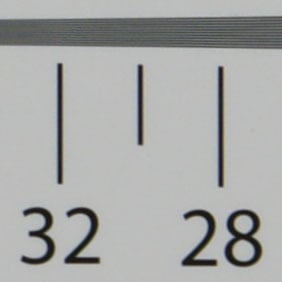Sony Alpha DSLR-A900
-
-
Written by Gordon Laing
Sony Alpha DSLR-A900 resolution comparison
Sony Alpha DSLR-A900 results continued…
Outdoor resolution / Studio resolution / High ISO Noise / Noise Reduction
| Support this site by shopping via these links | ||||||||||||||||||||||||||||||||||||||||||||||||||||
 |
To measure and compare the Sony Alpha DSLR-A900’s resolving power we photographed the Enhanced Digital Camera Resolution Chart with it and a number of rival cameras, each using their best quality JPEG and default image tone and sharpening settings. Each lens was tested at every aperture setting and the best result selected for this page. The crops are taken from the original images, saved as High Quality JPEGs in Photoshop CS2 and presented here at 100%. Each number represents 100 lines per picture height (lpph), so a figure of 20 means a resolution of 2000 lpph. |
In terms of resolving power, the Sony Alpha DSLR-A900 delivers 2900 and 3000 lpph of horizontal and vertical resolution respectively when equipped with the Sony Carl Zeiss 24-70mm f2.8 lens at f8. This makes it the highest resolution body we’ve tested at Cameralabs to date. The figures also show a measurable increase over the previous resolution leader, the Canon EOS 1Ds Mark III, which scored 2775 and 2650 lpph with a prime 85mm lens. Unsurprisingly coming behind these Megapixel giants are the Nikon D700 and Canon EOS 5D which both scored 2400 lpph (the Canon dipping a little below in vertical resolution). So the Sony Alpha DSLR A900 becomes the highest resolution non-medium format DSLR to date, and in terms of technical charts we don’t expect Canon’s forthcoming EOS 5D Mark II to give it any trouble. But as seen on the previous page, the A900’s extra pixels don’t allow it to capture perceptibly greater real-life detail than the Canon flagship in practice. Once again though, the fact Sony is offering this kind of resolution at a fraction of the price of the Canon flagship is an excellent result, although again Canon’s upcoming 5D Mark II shares the 1Ds Mark III’s resolution at a price which undercuts the Sony. Resolution is one thing, but noise levels at higher sensitivities are what make or break a camera for many people. So to find out how these bodies compare, head over to our Sony Alpha DSLR-A900 High ISO page, or scroll down to the bottom of this page to see whether shooting in RAW can affect the A900’s resolving power. |
Sony Alpha DSLR-A900 with Sony Carl Zeiss 24-70mm |
Canon EOS 1Ds Mark III with Canon EF 85mm f1.8 USM | |
 |  | |
2900 lpph, 24-70mm at 50mm, f8, 100 ISO |
2775 lpph, EF 85mm, f8, 100 ISO | |
Nikon D700 with Nikkor AF 50mm f1.8 |
Canon EOS-5D with Canon EF 85mm f1.8 USM | |
 |  | |
2400 lpph, 50mm at f8, 200 ISO |
2400 lpph, EF 85mm, f8, 100 ISO |
Sony Alpha DSLR-A900 with Sony Carl Zeiss 24-70mm |
Canon EOS 1Ds Mark III with Canon EF 85mm f1.8 USM | |
 |  | |
3000 lpph, 24-70mm at 50mm, f8, 100 ISO |
2650 lpph, EF 85mm, f8, 100 ISO | |
Nikon D700 with Nikkor AF 50mm f1.8 |
Canon EOS-5D with Canon EF 85mm f1.8 USM | |
 |  | |
2400 lpph, 50mm at f8, 200 ISO |
2300 lpph, EF 85mm, f8, 100 ISO |
Sony Alpha DSLR-A900 Studio resolution: JPEG versus RAW
We photographed our test chart in the Sony DSLR-A900’s RAW plus Large Fine JPEG mode, allowing us to directly compare images created from exactly the same data. Below are crops taken from the original JPEG file alongside the RAW version, processed in Sony’s supplied Image Data Converter SR version 3.0 using the default settings.
The RAW version shows a fractionally different approach to processing, but there’s essentially no difference in the result – the resolution figures remain the same. This corresponds with what we saw on the previous page where the processed RAW file was virtually identical to the in-camera JPEG.
So once again, Sony’s supplied RAW converter doesn’t offer much benefit over in-camera JPEGS when using the default settings, although of course further tweaking or the use of alternative RAW software could deliver superior results.
Now let’s check out the camera’s performance at different sensitivities in our Sony Alpha DSLR-A900 High ISO noise results page.
Sony Alpha DSLR-A900 JPEG with Sony Carl Zeiss 24-70mm |
Sony Alpha DSLR-A900 RAW with Sony Carl Zeiss 24-70mm | |
 |  | |
2900 lpph, 24-70mm at 50mm, f8, 100 ISO |
2900 lpph, 24-70mm at 50mm, f8, 100 ISO |
Sony Alpha DSLR-A900 JPEG with Sony Carl Zeiss 24-70mm |
Sony Alpha DSLR-A900 RAW with Sony Carl Zeiss 24-70mm | |
 |  | |
3000 lpph, 24-70mm at 50mm, f8, 100 ISO |
3000 lpph, 24-70mm at 50mm, f8, 100 ISO |




